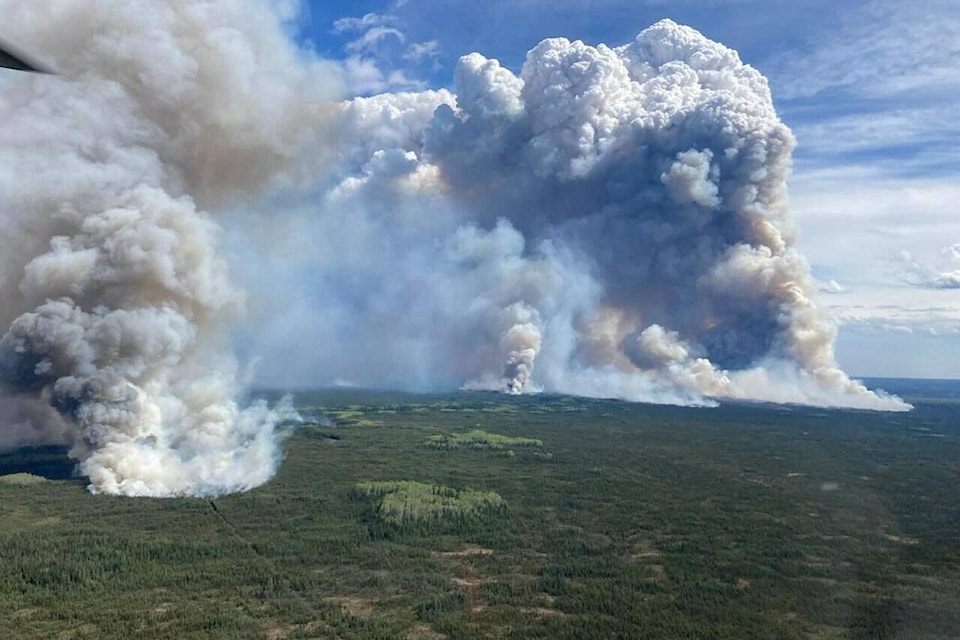No homes have been lost as a wildfire nudges toward the northeastern B.C. community of Fort Nelson, where the weather will play a key role in determining the fate of the firefight, Premier David Eby said Tuesday.
Approximately 4,700 people from the community and neighbouring First Nation remain under an evacuation order due to the 84-square-kilometre Parker Lake fire burning just a few kilometres west of town.
“The situation is still very fluid and very dependent on weather over the next 24 hours,” Eby told an unrelated news conference, while assuring residents that fire crews would “continue to do what is necessary to protect their homes.”
B.C.’s Emergency Minister Bowinn Ma late Tuesday morning pegged the grand total of evacuees at 4,850. “The situation is still extremely volatile,” she said. “The fire is not under control.” She added that evacuees continue to receive support, but could not provide an estimate about when they might be able to return.
An updated estimate from the BC Wildfire Service says the blaze saw a significant increase in size since Monday, when it was mapped at about 53 square kilometres in size.
Forecasts are calling for wind that may blow the fire closer to Fort Nelson, which has been under an evacuation order since Friday.
Fort Nelson resident Bud Streeper posted a video update on Tuesday showing some rain falling in the area.
“Definitely not a downpour, but a steady little sprinkle right now,” he said in the video.
Ken Dosanjh, a meteorologist with Environment Canada, said the community is not likely to see significant rain over the next few days, though up to five millimetres is possible.
He said areas south of town could see up to 20 millimetres Wednesday.
“We do have a Gulf of Alaska low that’s crashing into the coast as we speak, and then it’s going to start to move through the Interior by Wednesday. And so for Wednesday, we’re going to start to notice that low eventually make it to the northeastern parts of the province,” he said Tuesday.
“As it does, it’s going to be unstable, and it’s going to bring some rain associated with it, and possible risk of thunderstorms. However, so far things have been fairly consistent in showing most of the precipitation will kind of lie south of Fort Nelson.”
The Parker Lake fire is also contributing to woes south of the border, with smoke from it and other Canadian fires leading to health warnings across the Upper Midwest and Montana.
Fires in B.C. and Alberta filled the skies with haze over parts of Montana, the Dakotas, Minnesota and Wisconsin on Sunday, lingering into Monday.
The Minnesota Pollution Control Agency warned residents to avoid heavy exertion outdoors in its first statewide air-quality alert of the season.
Environment Canada has posted notices for parts of B.C., Alberta, Saskatchewan and the Northwest Territories warning about wildfire smoke.
Forecasters say the fine particles in smoke pose health risks and are more likely to impact seniors, pregnant women, people who smoke, infants and young children, as well as those with chronic illnesses.
“Those who are more likely to be impacted should reduce or reschedule strenuous activities outdoors or seek medical attention if experiencing symptoms,” the notices say.
The Parker Lake fire is not the only significant blaze burning in British Columbia.
On Monday, evacuation orders were issued for the Doig River First Nation and part of the Peace River Regional District as a separate 597-hectare fire burns near the community about 70 kilometres northeast of Fort St. John.
The district told residents to grab what they need and drive south to an evacuation centre in Fort St. John.
An update from Doig River First Nation Tuesday said the area is seeing an increase in humidity and lower temperatures “which is promising, but we are remaining vigilant.”
“Sprinklers have been activated amongst the community for additional structural protection measures. Currently the community is safe, animals are taken care of,” the statement says.
Northern Rockies Regional Municipality Mayor Rob Fraser, who represents Fort Nelson, said emergency operations centre staff have been calling as many residents who stayed behind as they could and managed to convince some to leave.
Fraser said he suspected about 50 residents were still in town, along with essential and critical staff.
“This is really going to be weather dependent, and so far the weather has been holding with us,” Fraser said in a video posted to Facebook. He said winds Sunday kept the flames from moving any closer into town.
He also said there is still electricity and water in Fort Nelson, but power is of particular concern for evacuees worried about their homes.
Fraser said it has been challenging for essential staff, including firefighters, to find food since the evacuation.
Several significant fires are burning across Western Canada.
A fire close to Cranberry Portage in northwest Manitoba forced about 550 residents from their homes, while a fire that prompted an evacuation alert in Fort McMurray, Alta., appeared to be holding about 16 kilometres southeast of the city.
READ ALSO: Evacuation calls expand in northeastern B.C. as Fort Nelson wildfire grows
READ ALSO: Wildfire that caused evacuation of Fort Nelson caused by downed tree: mayor
-with files from Wolf Depner
